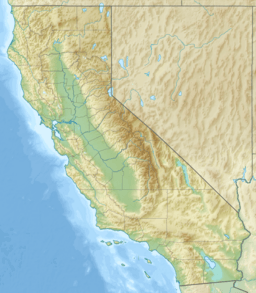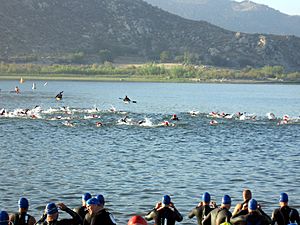Lake Perris facts for kids
Quick facts for kids Lake Perris |
|
|---|---|
| Location | Lake Perris State Recreation Area Riverside County, California |
| Coordinates | 33°51′25″N 117°10′30″W / 33.857°N 117.175°W |
| Type | Reservoir |
| Basin countries | United States |
| Max. depth | 100 ft (30 m) |
| Surface elevation | 486.3 m (1,595 ft) |
| Islands | Alessandro Island |
Lake Perris is a large human-made lake that was finished in 1973. It's the very end point of the huge California State Water Project, which brings water to many parts of California. You can find Lake Perris in a valley surrounded by mountains, between the cities of Moreno Valley and Perris.
This area is now known as the Lake Perris State Recreation Area. It's a popular spot for many fun outdoor activities. Because it's close to big cities and offers so much to do, it gets very busy, especially in the summer.
It's important to know that you should be careful if you catch fish here. The California Office of Environmental Health Hazard Assessment suggests that it's safest not to eat fish from Lake Perris. This is because small amounts of mercury and other chemicals have been found in them.
Contents
Ya'i Heki' Regional Indian Museum
The Ya'i Heki' Regional Indian Museum is a special place where you can learn about two main things. First, it tells the amazing story of the California State Water Project. This project is a huge system that moves water all across California.
Second, the museum teaches visitors about the history and culture of the native people who lived in the southern California desert region a long time ago. It's a great way to understand the area's past.
Geography of Lake Perris
Lake Perris sits about 1,560 feet (480 m) above sea level. It's surrounded by hills and small mountains, making for a beautiful view. The lake holds a lot of water, about 131,400 acre-feet (162,100,000 m3). This water is held back by a 2-mile (3 km) long dam that is 128 feet (39 m) tall.
Some parts of the land around Lake Perris are quite rocky and don't have many plants growing. There's also a cool secret underwater: an artificial reef made from old tires. This reef was put there to create a safe home for fish in the lake.
Plants and Animals at Lake Perris
The main type of plant life around Lake Perris is called coastal sage scrub. This kind of environment is home to many different birds and other wildlife.
Wildlife You Might See
You might spot animals like mule deer, roadrunners, bobcats, coyotes, rabbits, quail, gopher snakes, and even rattlesnakes. These animals usually try to stay away from people. You're more likely to see many kinds of lizards, rodents, water fowl, and birds of prey.
If you visit between November and April, which is the rainy season, you'll see beautiful displays of wildflowers blooming everywhere.
Plant Life and Adaptations
The coastal sage scrub plants grow mostly on the sunny, south-facing slopes of the Russell mountains and Bernasconi hills. These plants are often shrubby and include desert encelia, brittlebush, sagebrush, black sage, white sage, buckwheat, and various cacti.
On the shadier, north-facing hillsides, you'll find chaparral plants like chamise, penstemon, and poison oak.
Some of the original perennial grasses that used to cover this area can still be found near the lake. However, many of the plants in the valley grasslands now, like Russian thistle, were brought over from Europe by early settlers. Near springs and the lake's edges, you'll find riparian plants such as willows, cattails, elderberry, and nettles.
Many plants and animals at Lake Perris are very good at living in a hot and dry place. For example, chamise plants have tiny, waxy leaves. This helps them lose less water from evaporation. Some grasses and wildflowers grow, bloom, and make seeds very quickly, finishing their whole life cycle during the short wet season. Kangaroo rats are so good at living in dry places that they almost never drink water. They get all the moisture they need directly from their food!
Bird Watching at the Lake
More than a hundred different kinds of birds have been seen at Lake Perris. Many birds just stop here for a short time during their long migrations, while others live here all year. You might spot Meadowlarks, loggerhead shrikes, roadrunners, California thrashers, quail, wrens, sparrows, hummingbirds, golden eagles, different types of hawks, ospreys, and even bald eagles.
Many waterfowl use the lake, including pintails, widgeons, teals, mallards, shovelers, various geese, and sometimes even tundra swans and pelicans. Birds that like to stay near the water's edge include black-necked stilts, avocets, killdeer, willets, kingfishers, egrets, and herons.
Fish in Lake Perris
Lake Perris is a great spot for fishing. You can find many types of freshwater game fish here, such as Largemouth bass, spotted bass, bluegill, rainbow trout, channel catfish, black crappie, red ear sunfish, and carp. Because the weather is warm, the California Department of Fish and Game regularly adds rainbow trout to the lake during the winter months.
Here are the biggest fish of each type ever caught in Lake Perris:
- Alabama spotted bass – 9 pounds, 6 ounces
- Florida largemouth bass – 17 pounds, 6 ounces
- Bluegill – 3 pounds, 15 ounces
- Rainbow trout – 7 pounds
- Channel catfish – 30 pounds
Most people who fish here try to catch Largemouth bass, bluegill, rainbow trout, channel catfish, black crappie, and redear sunfish. The trout usually bite best in the cooler months, especially right after they are added to the lake.
Day and night, you can often see hawks and owls hunting for food. The bike trail around the lake is an easy way to see some of the birds and other wildlife. The best times to go are early morning or at dusk. Rangers also lead hikes during the spring and early summer.
Fun Activities at Lake Perris
There are tons of fun things to do at Lake Perris and in the State Recreation Park! You can go on guided hikes around the lake, and there are several places to go camping right by the water.
The lake is open for boating from 6:00 am to 6:30 pm, Thursday through Monday. Other popular activities include fishing, picnicking, horse-back riding, swimming (but only in special areas), and rock climbing. The park also hosts the yearly Big Rock Triathlon, which is a race with swimming, biking, and running. Don't forget, there's also a museum on the park grounds to explore!
Weather at Lake Perris
Lake Perris and the areas around it have hot, dry summers and cool, wet winters. Most of the rain falls during the six months between November and April. The area gets different kinds of weather. Sometimes, coastal fog and smog blow in from the west. Other times, strong, hot, dry winds called "Santa Anas" come from the deserts to the east and northeast.
The water in the lake is usually around 70 °F (21 °C). In the summer, it gets as warm as bathwater, which is perfect for swimming!
Lake Perris Water Level Changes
After July 2005, the water level in Lake Perris was lowered by about 20 percent, which is about 24 feet. This was done because of safety worries about the dam. A big study showed that the dam could be partly damaged if a very strong earthquake (7.5 magnitude or higher) happened nearby.
Engineers were especially concerned because the San Jacinto Fault, which can cause a 7.5 magnitude tremor, is only a few miles north of the lake. It might take more than two years for the state to figure out how to make the dam stronger.
Even with the lower water level, most recreational activities are still allowed, but with some changes. For example, the area where boats can go fast (35 mph (56 km/h)) is now smaller, only between the dam and Alessandro Island. The area from the island eastward is now a slow, 5 mph (wakeless speed) zone. Swimming is only allowed at Perris Beach (Lots 1, 2, 3, and 4).
If you want to bring a boat in the summer, it's a really good idea to make a reservation because spots sell out quickly on weekends. Since the water level was lowered, there are fewer spots for boats that are given out on a first-come, first-served basis. In the summer of 2006, most reservations were sold out a week or two ahead of time.
Lake Perris and the 2028 Summer Olympics
The city of Los Angeles, which is hosting the 2028 Summer Olympics, has made a plan with the Department of Parks and Recreation. They want Lake Perris to be the place for the competitive Canoe-Sprint and rowing events.
The Olympic committee chose Lake Perris over Lake Casitas because Lake Perris is closer to more people and is near the UCR, which could be used for athletes' housing. However, in February 2019, the International Rowing Federation said they were asked to also consider using Long Beach Marine Stadium (where the 1932 Olympic rowing events were held) instead of Lake Perris. A final decision has not yet been made.



